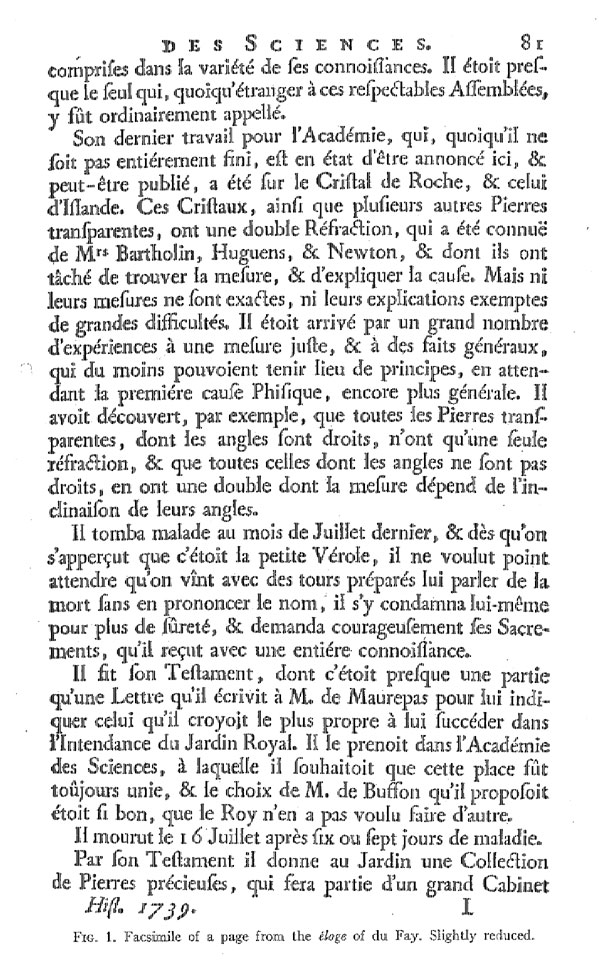| Home | AmMin | GMR | RiMG | Collectors Corner | Directory | Short Courses | |
|
|
|||||||

|
|
Volume 17, pages 569-572, 1932
CHARLES-FRANCOIS DU FAY, A PIONEER IN CRYSTAL OPTICS ADOLF PABST, University of California. The foundations for correlation of the optical properties of crystals with their form or symmetry were laid in the second decade of the nineteenth century by Biot and Brewster.1 Their success depended on the use of polarized light. Haüy had attempted to distinguish between singly and doubly refracting crystals and had correlated optical isotropism with certain highly symmetrical molécules intégrantes, but his method, observing the image of a pin through crystal prisms, could not lead to satisfactory results. Some eighty years before Brewster the first correlation of crystal form and optical properties was attempted by Charles-Francois de Cisternai du Fay. Unfortunately his early death prevented the full publication of his results and the only knowledge we have of his work is from the éloge written by de Fontenelle, at that time secrétaire perpétuel of the Academie.2 Du Fay was born in Paris, September 14, 1698, of a family long accustomed to the profession of arms. He also entered the military service, but after a brief career as a lieutenant he began to devote himself to chemistry and in 1723, at a remarkably early age, he became a member of the Academic des Sciences as a chemist. During the next fifteen years he was active in all the branches of science then recognized and made important contributions to the Memoires of the Academic. His best-known work was in the fields of electricity and phosphorescence, and this is usually cited in the histories of physics. Within a few years he attained such a reputation as a successful experimenter that he was engaged by the royal council to work out chemical tests for the quality of dyes. In 1732 the king appointed du Fay superintendent, intendant, of the royal gardens and in this capacity he was an active botanist until his death, July 16, 1739, after a brief illness. It must have been during these last years that he did his work on the optical properties of crystals. The éloge by de Fontenelle is charmingly written with many sidelights on the conditions of the time and interesting reflections on international scientific cooperation and the relations of scientists and diplomats. In figure 1 is reproduced that page of the éloge which contains the mention of du Fay's work on crystals. The paragraph of chief interest, freely translated, follows. His last work for the academy, which, though not quite complete, is far enough advanced for announcement and possibly for publication, has been on rock crystal and iceland spar. These crystals, like many other transparent stones, have a double refraction which was known to Bartolinus, Huyghens and Newton and which they tried to measure and explain. But neither are their measurements exact, nor their explanations free from great difficulties. By a great number of experiments he arrived at exact measurements and general facts, which however, considering the first physical cause, may represent even more general principles. He discovered, for instance, that all transparent stones which have right angles are but singly refracting, whereas those whose angles are not right angles are doubly refracting and that the measure of their double refraction depends on the inclination of their angles. De Fontenelle does not state the basis for these remarks but it seems certain that he must have had before him some notes or unfinished manuscript. Being a poet he probably was little able to interpret or to judge du Fay's work. One wishes for a more complete report. By what means did du Fay arrive at better determinations of refraction than his forerunners? Just what fault did he have to find with their explanations? If his notes or manuscript can be found it would be most desirable to have them made available. Under the circumstances it is impossible to say how far the erroneous or ambiguous statements in the quotation above are due to du Fay and how far they are due to the author of the éloge. In any event it is certain that du Fay should be credited with a great achievement. It seems that he discovered the optically isotropic character of isometric crystals, the anisotropic character of all other crystals, and the fact that the amount of birefringence is, in general, different for each species. He had taken the first steps toward a correlation of crystal form and optical properties. The knowledge of his predecessors was limited to the fact that calcite and quartz are birefringent. At that time when no attempt at crystal classification had yet been made and when testing for birefringence by polarized light was unknown, he could hardly be expected to accomplish more.
Du Fay has been sadly slighted by the historians of crystallography, probably because of the unusual and incomplete manner in which his results were published. Groth 3 fails entirely to mention him. Kobell4 mentions him only for his work on phosphorescence.As previously stated he is mentioned by several historians of physics. So far as the writer is aware only one of these, Edmund Hoppe, 5 refers to du Fay's work on the optics of crystals.NOTES 1 David Brewster, On the laws of polarization and double refraction in regularly crystallized bodies: Phil. Trans. Roy. Soc. London, 1818, pp. 199-273. 2 Histoire de I'Academie Royale des Sciences, 1739, pp. 73-83, Paris, 1741. 3 P. Groth, Entwicklungsgeschichte der Mineralogischen Wissenschaften, Berlin, 1926. 4 F. von Kobell, Geschichte der Mineralogie, pages 32 and 70, Munich, 1864. 5 Edmund Hoppe, Geschichte der Physik. p. 260. Braunschweig, 1926.
|
